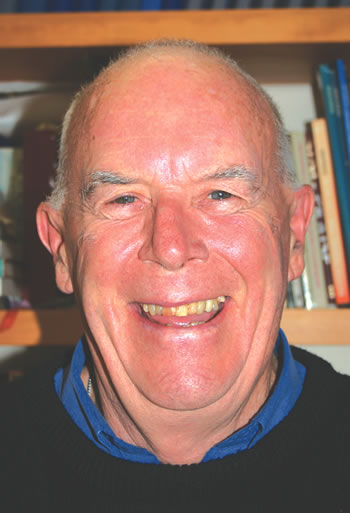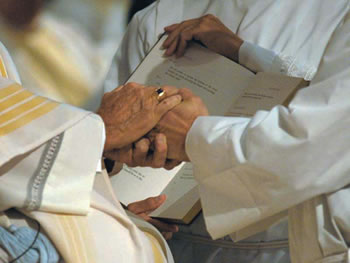Everyone A Priest
What follows is the text of a Sermon Preached by
Fr John Rea sm
It happened some time during the exodus. The Israelites were drawn up in their tribes around the tent of meeting. They were grumbling and their discontent was aimed at Moses and Aaron. Then God intervened. He showed his presence in a bright and shining cloud above the tent. At the same time plague began to sweep from right to left through the ranks. Moses said to Aaron: Take your censor, put fire therein from the altar, and lay incense on it. Carry it quickly to the congregation. For wrath has gone forth from the Lord. … So Aaron ran into the midst of the assembly and made atonement for the people. He stood between the dead and the living and the plague was stopped. Numbers 16: 42ff.
Moses gave the order and Aaron, whom he’d ordained, acted as a priest. He interceded, interposed, got in between God and the people. He offered an incense sacrifice. He put his life on the line. It took faith, it took courage, it took faithfulness to the office of priest for him to run to the place of greatest danger where people were dying, cut down like grass before a scythe. That day Aaron showed us plainly what it is to be a priest. It is to stand between people and God, to offer sacrifice, to mediate, to be a go-between, a bridge between the Creator on the one hand, and men and women on the other.
Centuries after this event, the Lord God spoke through one of Aaron’s descendants, the priest/prophet Ezekiel, and said: I sought for a man among them who should build up the wall and stand in the gap before me on behalf of the land, that I should not destroy it, but I found none.
A man to stand in the gap. A man to build up the wall. What God was looking for was a priest, because that’s a priest’s role: to stand in the gap on behalf of the land. As it is written in the Letter to the Hebrews: Every high priest has been taken out of mankind and is appointed to act for men in their relations with God, to offer gifts and sacrifices for sins.
God made his plea through Ezekiel. It was only answered fully when the Father sent his Son, Jesus, to be the bridge between himself and us, to fill the gap caused by the Fall. So it is that Paul instructs Timothy. There is only one God, and there is only one mediator between God and mankind, himself a man, Christ Jesus, who sacrificed himself a ransom for all. Again, in the letter to the Hebrews: Jesus is the Apostle and High Priest of our Confession. Nor did Christ give himself the glory of becoming high priest, but had it from the one who said to him, “You are my Son, today I have become your Father,” and in another text, “You are a priest after the order of Melchisedech and forever.”
Strictly speaking, for us Christians there is only one priest and that priest is Jesus. Paul, inspired by the Holy Spirit speaks about the seven fold one-ness of the Church. “There is one body and one Spirit, just as you were called to the one hope that belongs to your call, one Lord, one faith, one Baptism, one God and Father of us all, who is above all and through all and in all.” But to these seven “ones” we can add an eighth … there is one priest. Anyone, other than Jesus, whom we call “priest” is only a priest in so far as he or she shares in Christ’s unique and eternal priesthood.
All the baptized are priests. Peter makes this point twice in the second chapter of his first letter. “… Be yourselves built into a spiritual house, to be a holy priesthood, to offer spiritual sacrifices acceptable to God, through Jesus Christ.” That’s verse five. And in verse nine; “But you are a chosen race, a royal priesthood, a holy nation, God’s own people.” In his letter to the Romans, Paul urges us all to act as priests; “I appeal to you therefore, brethren, by the mercies of God, to present your bodies as a living sacrifice, holy and acceptable to God, which is your spiritual worship.” (Rom.12: 1).
From the Body of the Faithful the Lord calls certain men to serve the rest in a totally different kind of priesthood. The official teaching of the Church sums it up in these words; “(priests) are marked with a special character and are so configured to Christ the priest that they can act in the person of Christ the Head.” [PO/2]
The late Mgr Ronald Knox helps us appreciate this statement with a useful parallel. He writes about the ministerial priest and quotes Genesis 2 on creation, and John 20 about new creation. He declares: “ ‘The Lord God fashioned man of dust from the soil. Then he breathed into his nostrils a breath of life, and man became a living being.’ ” Centuries later God breathed into the face of man once more … “Receive the Holy Spirit, for whose sins you forgive, they are forgiven.”
That’s what priestly ordination is … a new creation. In the hour that ministerial priests are ordained they are changed and changed forever. They are torn apart and re-made in the deepest roots of their being. In the depths of their personality, where all of us are most truly ourselves, at the level of life-directing and life-determining choices, they are set on a new path, a fresh course, the way of Christ, Priest and Head. A more shattering change this, and more radical, than any seen or measured in the world about us. It is a transformation comparable in some ways to that which takes place in the infant when it is baptized. And, dare I say, it is something like the change in the bread and wine at the Consecration but, of course, not substantial. Here is cause for awe and wonder … the mystery of the Catholic Priesthood … mere men become Christ in and to and for the world. In the moment ministerial priests are ordained they are changed and changed forever. A likeness to Christ the Priest is branded into their being. To quote St John Chrysostom, they lend their voices and their hands to Christ. In the words of the Second Vatican Council they assume the person of Christ himself. (PO/12.) The Catholic Catechism describes them as icons of Christ the Priest. St John Paul ll enlarges on this and calls priests “living and transparent images of Christ the Priest.”
From the moment they are ordained, and forever, priests are in Christ and for Christ and with Christ at the service of humankind. They are empowered to act in the Person of him who is prophet, priest, and king. The Lord Jesus gives his ministerial priests a particular share in all three ministries: not just that of worship through Mass and Sacraments but also the prophetic through teaching and preaching, and leadership through pastoring the flock. Each ministry interacts with the other two and the Most Holy Eucharist controls all.
The Lord Jesus is supremely priest in the Sacrifice of the Cross. And that Sacrifice is represented, re-presented, re-enacted sacramentally in the Holy Eucharist. Ministerial priesthood is grounded in Jesus Christ and grounded in the Eucharist. But notice it is ordered to the priesthood of the laity. It is for the sake of the lay priesthood. It aims at promoting that priesthood. Pope St John Paul declares that “the ministerial priesthood does not of itself signify a greater degree of holiness than the priesthood of the faithful. Through it, Christ gives to priests, in the Spirit, a particular gift so that they can help the People of God to exercise faithfully and fully the priesthood which it has received.” In other words ministerial priests are servants to the priestly people of God.
For goodness sake, Sisters and Brothers, please don’t put ministerial priests on a pedestal. That’s not the place for servants. Besides, they may fall off. But please exercise your priesthood on their behalf and pray for them. Pray that Jesus’s word in John 12 will be fulfilled in them. “If anyone serves me, he must follow me; and where I am, there shall my servant be also; if anyone serves me, the Father will honour him.”
Pray for your priests.


 Entries(RSS)
Entries(RSS)